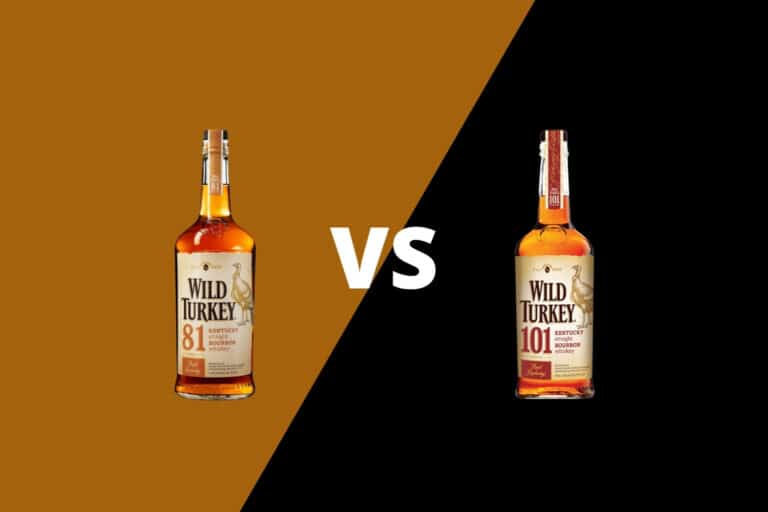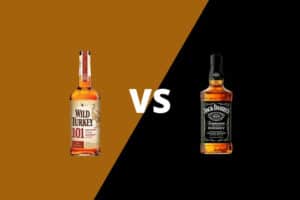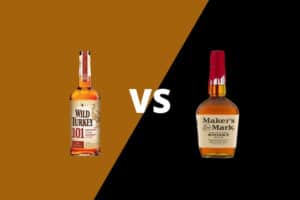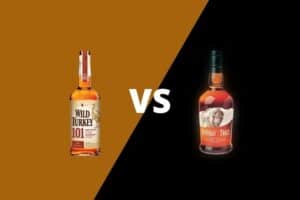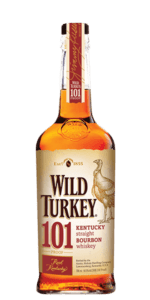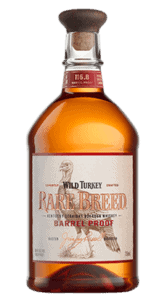Do you see those two bottles of Wild Turkey on the shelf? Want to know what makes them different so you know whether the increase in the proof is relative to the increase in price?
Look no further. We’ve got you covered.
In this post, we’ll go down the rabbit hole to share everything you need to know about the Wild Turkey brand and these two offerings.
Table of Contents
History
The Wild Turkey bourbon brand was launched by the Austin Nichols company in 1942.
Austin Nichols began as a distributor and wholesaler in New York City in the mid-1800s. After Prohibition ended in 1933, the Austin Nichols company began selling whiskies as a non-distiller producer or NDP. The leading whiskey supplier was the J.T.S. Brown Distillery owned by the Ripy family near Tyrone, Kentucky.
Prohibition was the period in American history between 1920 and 1933 when the production, sale and consumption of alcoholic beverages were made illegal by the 18th Amendment to the Constitution. By the time this law was repealed by 21st Amendment in 1933, nearly a whole generation of Americans was introduced to alcohol for the first time.
Before Prohibition, bold and flavorful bottled-in-bond bourbon and rye whiskeys were the most popular tipple in the United States. But during Prohibition, the American palate changed. Many cocktail innovations were introduced during this period, as bartenders at speakeasies looked to make mixed drinks that appealed to both men and women with whatever liquor ingredients could be obtained — everything from bathtub gin to imported Canadian whiskey to illicit moonshine and rums smuggled from the Caribbean.
After repeal, new drinkers had forgotten the bold flavor of 100-proof bonded bourbon and Monongahela rye whiskeys. To produce mass quantities of whiskey as quickly as possible, producers aged whiskey less than the requisite four years required by the Bottled in Bond Act and relied on blended whiskey formulas that took advantage of minimally-aged spirits to meet booming demand.
So, when Wild Turkey was released in 1942 as an eight-year-old 101-proof bourbon, it was a throwback to times gone by. And when Master Distiller Jimmy Russell was hired in 1954, he shepherded the bold bourbon style through some bleak times in the 1970s, 80s and 90s — when bourbon neat was considered the order of old-timers and drunks.
Today, Jimmy’s son Eddie Russell carries on as master distiller. While most brands started with an introductory 80-proof bourbon — the minimum alcoholic strength allowed by law — only to later release high-proof bonded-style bourbons as a way to premiumize their product, Eddie Russell did the reverse — releasing Wild Turkey 81 to showcase the bourbons flavor profile at a lower proof and more affordable cost. Recently rebranded as Wild Turkey Bourbon, the 81-proof line extension introduces the category to new category entrants, along with Wild Turkey American Honey, initially launched in the 1970s as Wild Turkey Liqueur — one of the first flavored bourbon products on the market.
Mashbills
U.S. regulations require bourbon to have a mash bill — or list of grain ingredients — containing 51 percent or more corn. The remainder of the recipe is considered flavoring grain. Wild Turkey’s high-rye recipe has a mash bill of 75 percent corn, 13 percent rye and 12 percent malted barley. Wild Turkey claims it never used genetically modified grains in its history of bourbon production.
Wild Turkey pulls water from the Kentucky River, which sits upon a limestone shelf that is a large part of Kentucky’s prominence in the whiskey industry. This water source is free of iron, which has the tendency to turn whiskey black if it’s not removed before the maturation process. In addition, the higher pH balance of this limestone-filtered water and its mineral-rich qualities help create an ideal environment for yeast during the fermentation phase. Finally, it’s an ideal source of dilution water.
Wild Turkey utilizes a proprietary yeast strain cultivated by Master Distiller Jimmy Russell six decades ago and a sour batch process to keep ferments consistent from batch to batch.
Distillation & Production
When Wild Turkey was launched, it was produced off-site and bottled by the Austin Nichols company. In 1971, it purchased the distillery to control the distillation and the production process for Wild Turkey and other products.
In 1980, the brand and facility were acquired by Paris-based Pernod Ricard. Then, Italian drinks company Gruppo Campari purchased Wild Turkey and the Wild Turkey Distillery in 2009. Three years later, a new Wild Turkey facility was opened with upgraded equipment and a visitor’s center in 2011.
Today, Wild Turkey utilizes a large 60-inch copper column still to make its whiskey at the new Wild Turkey Distillery new facility in Lawrenceburg, Kentucky.
Maturation
U.S. regulations require bourbon to be matured in new American charred oak barrels.
Wild Turkey uses No. 4 ‘alligator’ char barrels. Barrel char levels describe a scale of 1 to 5 that describes the duration the inside of the barrel is exposed to open flame. The char’s depth influences the way the liquid inside interacts with the barrel staves’ various levels — the red layer beneath the char and the oak that expends to the barrel’s exterior. In addition, the char helps to perform a charcoal carbon filtration that helps to mellow and smooth out the spirit inside. The red layer gives the bourbon its signature red or auburn color and much of its flavor from the caramelized wood sugars.
It should be noted the No. 5 barrel char level is a recent invention that is a result of innovation over the past decade or so. The bourbon boom has encouraged barrel coopers and craft brands to find ways to stand out with an additional claim on big, bold flavor. Some in the whiskey industry argue about the differences between Nos. 4 and 5 barrels, and others use the two somewhat interchangeably.
Although Wild Turkey was initially released as an 8-year-old bourbon, the age statement was removed during subsequent decades. Today, Wild Turkey claims in marketing materials that none of their whiskies are bottled under five years. This fact is reflected on the back label — which must be approved by the U.S. Alcohol and Tobacco Tax and Trade Bureau.
Wild Turkey’s maturation warehouses are the typical type of storage used in Kentucky — large, multistoried wooden structures with exterior tin sheeting to protect from the elements. The thin non-temperature controlled buildings allow heat to rise to the upper levels during Kentucky’s relatively hot summers, and cold, arid winter air to circulate throughout the barrel house in the cold winter months.
After distillation, bourbon new make spirit comes off the still below 160-proof. Bourbon regulations require the spirit to be entered into the barrel at a maximum of 125-proof. So, the distiller must dilute bourbon distilled to above that mark with water before placing it into the barrel.
Wild Turkey barrels its whiskey at 114-proof, a lower entry proof than many competitors. This means less water is added after dumping the barrels to get the bottle proof required of their brands.
The amount of water added for dilution is the most significant difference between Wild Turkey 101 or 81-proof bourbon expressions. But without speaking to the production team, we must note it’s impossible to know if the batching requirements for 81 and 101-proof versions are identical.
Ownership, Price & Value
The Wild Turkey bourbon brand is produced by Milan-based Italian drinks maker Gruppo Campari, or Campari Group. It is best known for its Campari and Aperol aperitifs. It also produces spirits brands, including Appleton Jamaican rum, SKYY vodka, Espolón tequila and Forty Creek Canadian whisky.
You can find Wild Turkey 101 for about $25 for a 750mL bottle at 101-proof, or 55.5 percent alcohol by volume.
You can find Wild Turkey Bourbon for about $22 for a 750mL bottle at 81-proof, or 40.5 percent ABV.
Tasting Notes
Wild Turkey Kentucky Straight Bourbon Whiskey, 81-proof
Description: In the glass, Wild Turkey Bourbon has a straw-gold hue and chestnut color with slight legs at 81-proof.
Nose: Honey and toffee, with new oak, tobacco, vanilla and caramel notes.
Palate: Honey and white chocolate, a bit of maple syrup and butterscotch. Corn sweetness, cinnamon, black pepper, vanilla.
Finish: Honey, oak, tobacco, black pepper, vanilla and cinnamon.
Wild Turkey 101-proof Kentucky Straight Bourbon Whiskey
Description: In the glass, Wild Turkey has a red-brown auburn color, with incredible legs at 101-proof.
Nose: The aromas of caramel and new oak, with toffee, chocolate and honey, with notes of leather and tobacco.
Palate: Corn sweetness with honey, caramel, vanilla, cinnamon and baking spices flavors, with notes of cherry, tobacco and leather.
Finish: Black pepper spice, with lingering tobacco, leather and a hint of maple syrup.
[Related: Complete Wild Turkey Review]
Verdict…
Whiskey experts often suggest adding a drop of high-quality mineral water to open up the nose and flavors when compiling tasting notes or comparing brands in a blind tasting.
This is the perfect example.
These bottles should be nearly identical, with the same mash bill, rye content, distillation and the only discernable difference being the amount of water added for dilution. But compared side-by-side, the lower-proof version showcases the honey and notes of caramel, while the high-proof version has more pepper, leather, tobacco and oaky notes. The prices are close enough that it really is up to the whiskey drinker’s taste preference as to which is the better deal.

